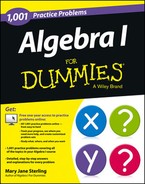Chapter 7
Multiplying by One or More Terms
Multiplying algebraic expressions is much like multiplying numbers, but the introduction of variables makes the process just a bit more interesting. Products involving variables call on the rules of exponents. And, because of the commutative property of addition and multiplication, arrangements and rearrangements of terms and factors can make the process simpler.
The Problems You'll Work On
When multiplying by one or more terms, you deal with the following in this chapter:
What to Watch Out For
With all the distributing and multiplying, don't overlook the following:
Distributing One Term Over Sums and Differences
311–315 Distribute the number over the terms in the parentheses.
311. 3(2x + 4)
312. −4(5y − 6)
313. 7(x2 − 2x + 3)
314. ![]()
315. ![]()
Distributing Using Division
316–320 Perform the division by dividing each term in the numerator by the term in the denominator.
316. ![]()
317. ![]()
318. ![]()
319. ![]()
320. ![]()
Multiplying Binomials Using Distributing
321–325 Distribute the first binomial over the second binomial and simplify.
321. (a + 1)(x − 2)
322. (y − 4)(z2 + 7)
323. (x + 2)(z − 2)
324. (x2 − 7)(x3 − 8)
325. (x2 + y4)(x2 − y4)
Multiplying Binomials Using FOIL
326–335 Multiply the binomials using “FOIL.”
326. (x − 3)(x + 2)
327. (y + 6)(y + 4)
328. (2x − 3)(3x − 2)
329. (z − 4)(3z − 8)
330. (5x + 3)(4x − 2)
331. (3y − 4)(7y + 4)
332. (x2 − 1)(x2 + 1)
333. (2y3 + 1)(3y3 − 2)
334. (8x − 7)(8x + 7)
335. (2z2 + 3)(2z2 − 3)
Distributing Binomials Over Trinomials
336–340 Distribute the binomial over the trinomial and simplify.
336. (x + 3)(x2 − 2x + 1)
337. (y − 2)(y2 + 3y + 4)
338. (2z + 1)(z2 + z + 7)
339. (4x − 3)(2x2 + 2x + 1)
340. (y + 7)(3y2 − 7y + 5)
Squaring Binomials
341. (x + 5)2
342. (y − 6)2
343. (4z + 3)2
344. (5x − 2)2
345. (8x + y)2
Raising Binomials to the Third Power
346–350 Raise the binomials to the third power.
346. (x + 2)3
347. (y − 4)3
348. (3z + 2)3
349. (2x2 + 1)3
350. (a2 − b)3
Using Pascal's Triangle
351–360 Raise the binomial to the indicated power.
351. (x + 3)4
352. (y − 2)5
353. (z + 1)6
354. (a + b)7
356. (4z + 1)4
357. (3y − 2)5
358. (2x + 3)6
359. (3x + 2y)4
360. (2z − 3w)5
Finding Special Products of Binomials and Trinomials
361–365 Distribute the binomial over the trinomial to determine the “special” product.
361. (x − 1)(x2 + x + 1)
362. (y + 2)(y2 − 2y + 4)
363. (z − 4)(z2 + 4z + 16)
364. (3x − 2)(9x2 + 6x + 4)
365. (5z + 2w)(25z2 − 10zw + 4w2)
